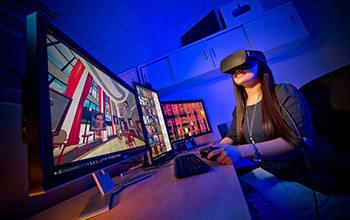Multimedia Gallery
Recalling information better through virtual reality
University of Maryland researchers conducted one of the first in-depth analyses on whether people recall information better through virtual reality as opposed to desktop computers.
More about this image
Virtual reality (VR) continues to grow in popularity for gaming and entertainment, but the technology also shows promise for changing the landscape of industries such as medicine, education and workforce training as well.
University of Maryland (UMD) researchers have conducted one of the first in-depth analyses on whether people learn better through virtual, immersive environments, or from more traditional platforms like a 2D desktop computer or hand-held tablet. Results of their study found that people remember information better if it is presented to them in a virtual environment.
"This data is exciting in that it suggests that immersive environments could offer new pathways for improved outcomes in education and high-proficiency training," says Amitabh Varshney, professor of computer science and dean of the College of Computer, Mathematical, and Natural Sciences at UMD. Varshney leads several major research efforts on the UMD campus involving virtual and augmented reality (AR) including close collaboration with health care professionals interested in developing AR-based diagnostic tools for emergency medicine and VR training for surgical residents.
The research was supported in part by the National Science Foundation (grants CNS 14-29404 and IIS 15-64212).
Read more about this research in the UMD news story People recall information better through virtual reality, says new UMD study. (Date image taken: March 2017; date originally posted to NSF Multimedia Gallery: Aug. 22, 2018)
Credit: John T. Consoli
See other images like this on your iPhone or iPad download NSF Science Zone on the Apple App Store.
Images and other media in the National Science Foundation Multimedia Gallery are available for use in print and electronic material by NSF employees, members of the media, university staff, teachers and the general public. All media in the gallery are intended for personal, educational and nonprofit/non-commercial use only.
Images credited to the National Science Foundation, a federal agency, are in the public domain. The images were created by employees of the United States Government as part of their official duties or prepared by contractors as "works for hire" for NSF. You may freely use NSF-credited images and, at your discretion, credit NSF with a "Courtesy: National Science Foundation" notation.
Additional information about general usage can be found in Conditions.
Also Available:
Download the high-resolution JPG version of the image. (4.5 MB)
Use your mouse to right-click (Mac users may need to Ctrl-click) the link above and choose the option that will save the file or target to your computer.

